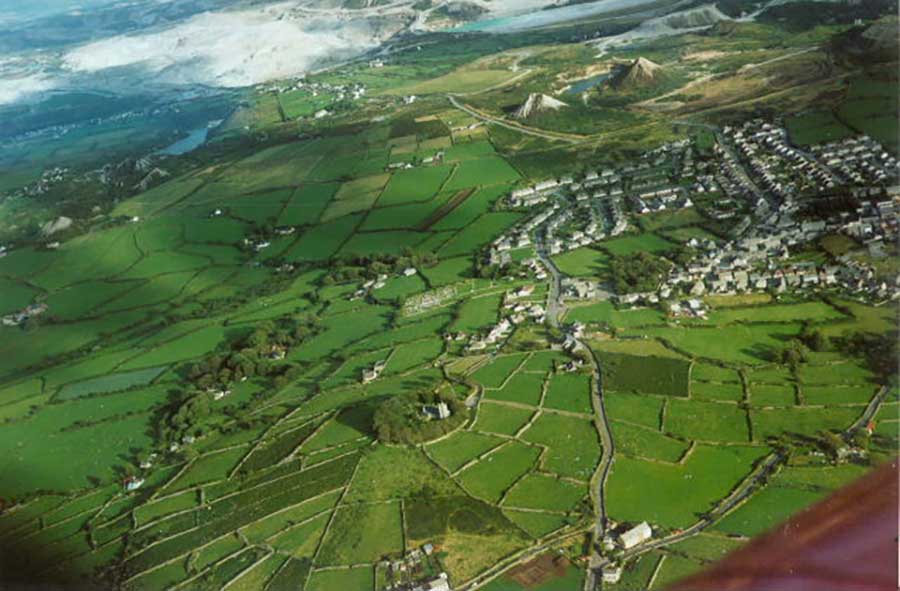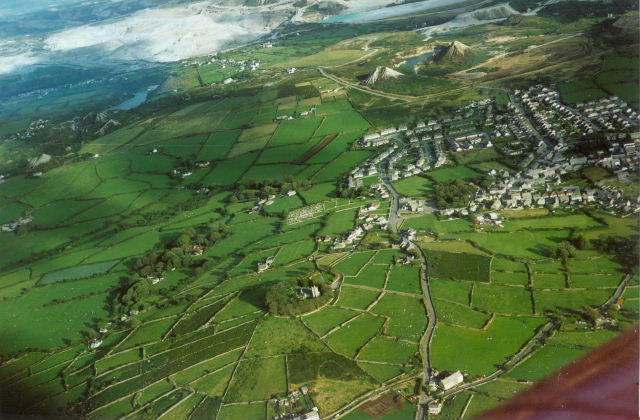Image by Talskiddy at English Wikipedia, CC BY-SA 3.0, via Wikimedia Commons

St Dennis, a village in mid-Cornwall and home to Demolition South West (DSW), has a rich and diverse history that spans thousands of years, from its Neolithic beginnings through the Celtic and Norman periods, and into the modern era. Over the centuries, the landscape around St Dennis has been shaped by human activity, from farming and trade to the later development of Cornwall’s famous china clay industry. The area’s historic Domellick Manor and the St Dennis hillfort (it is thought that the name ‘Dennis’ is derived from the Cornish word for hill fort, ‘Dinas’) are central to this story, serving as important landmarks throughout various eras. St Dennis’ role as a focal point in the region extends even further into the modern period, with the growth of the china clay industry in the 19th and 20th centuries, which transformed the local economy and landscape.
Neolithic and Bronze Age Beginnings
The earliest human activity around St Dennis dates back to the Neolithic period (4000–2500 BCE). Early farming communities settled in the area, cultivating the land and making use of nearby resources, such as those found in the Goss Moor. By the Bronze Age (2500–800 BCE), the population had grown, and more permanent settlements began to emerge, including burial mounds or barrows that can still be found near St Dennis. These barrows often held the remains of important community members, showing a developed society that valued its leaders.
Celtic St Dennis and its Hillfort
By the Iron Age (800 BCE–100 CE), the region was inhabited by the Dumnonii tribe, who built several hillforts in mid-Cornwall, including the fort at St Dennis. Perched on the highest point of the village, the St Dennis hillfort would have served both as a defensive position and as a centre for trade. Cornwall’s rich deposits of tin and copper, valuable metals for the wider European trade network, made the area strategically important. The hillfort would have played a role in protecting these trade routes and managing the local economy.
The Norman Period and Domellick Manor
Following the Norman Conquest of 1066, Cornwall underwent significant political changes, as the Normans imposed their feudal system on the region. Domellick Manor, located near St Dennis, became part of the extensive estates granted to Robert, Count of Mortain, William the Conqueror’s half-brother. Recorded in the Domesday Book of 1086, Domellick was a significant manor with a productive agricultural economy, consisting of arable land, livestock, and woodland.
The manor’s influence extended across several villages, including St Dennis, Roche, St Stephen-in-Brannel, and St Columb Major, with St Austell emerging as the closest major town. During this time, St Dennis hillfort transitioned into a religious site, with the Church of St Dennis being built on the hill’s summit, a legacy of the Norman period that persists to this day.
The China Clay Industry and Modern St Dennis
By the 18th century, Cornwall had become world-famous for its tin and copper mining, but the industrial revolution brought a new material to the forefront of the local economy—china clay (kaolin). Discovered by the chemist William Cookworthy in the mid-1700s, Cornwall’s deposits of china clay became increasingly important for making porcelain and pottery, particularly as demand for high-quality ceramics soared.
St Austell, just a few miles from St Dennis, became the centre of Cornwall’s china clay industry, and this economic boom extended into surrounding villages like St Dennis. The china clay quarries transformed the landscape, creating vast pits and spoil heaps, most of which are still visible today. By the mid-19th century, the industry was well-established, employing thousands of people in the region. Villages such as St Dennis, Roche, and Nanpean became closely tied to this industry, with many local residents finding work in the quarries or associated processing plants.
The rise of the china clay industry also brought significant infrastructure development to the area. Railways and transport networks were built to ship the clay from Cornwall to markets around the world. By the early 20th century, Cornwall was producing the majority of the world’s china clay, and the industry continued to play a crucial role in the local economy well into the 20th century. The influence of this industry was not just economic but also environmental, as the clay works left an indelible mark on the local landscape.
The Influence of St Dennis on Surrounding Villages and Towns
Throughout its long history, St Dennis has had a notable influence on surrounding villages and towns. During the medieval period, Domellick Manor played a central role in the agricultural and feudal economy, influencing villages like Roche, St Stephen-in-Brannel, St Columb Major, and Nanpean. The area’s strong agricultural economy supported both the local population and the wider Cornish market.
In the industrial era, with the rise of the china clay industry, St Dennis and its surrounding villages became even more interconnected. The proximity to the china clay quarries meant that villages like Nanpean and St Stephen-in-Brannel were directly involved in this industrial expansion. St Austell, already the main town in the region, grew significantly due to the industry, becoming a hub for the processing and export of china clay.
While the clay industry has declined in recent years, its legacy is still visible across the region. The remnants of the quarries, spoil heaps, and processing plants are now part of Cornwall’s industrial heritage, and many former clay pits have been reclaimed and transformed into nature reserves or other community projects, such as the world-renowned Eden Project, built in a former china clay pit just outside of St Austell.
Conclusion
The history of St Dennis and the surrounding area is a testament to the region’s ability to adapt and evolve over time. From its Neolithic and Celtic roots to its importance during the Norman period and later industrial boom, St Dennis has remained a significant focal point in Cornwall. The establishment of Domellick Manor during the Norman era connected the village to a wider feudal system, with its influence extending across neighbouring villages and towns.
The rise of the china clay industry in the 18th and 19th centuries brought a new wave of economic prosperity, transforming St Dennis and the entire region into a key industrial hub. Today, while the china clay industry has largely declined, its impact remains deeply woven into the fabric of the local landscape and community. Villages like Roche, Nanpean, and St Stephen-in-Brannel, along with St Austell, owe much of their modern development to the china clay boom, while the historical landmarks of St Dennis—its hillfort and parish church—stand as reminders of the village’s long and enduring legacy in Cornwall.


